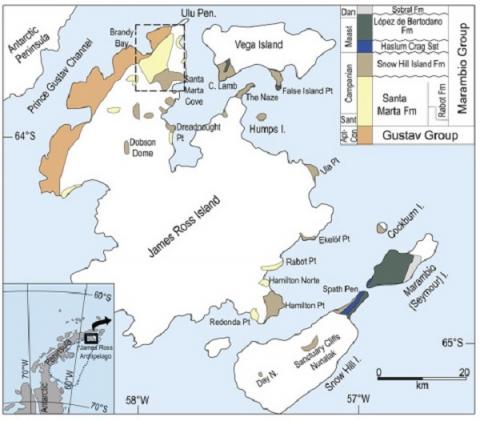Florencia N. Milanese, Eduardo B. Olivero, Sarah P. Slotznick, Thomas S. Tobin, María E. Raffie, Steven M. Skinner, Joseph L. Kirschvink, Augusto E.Rapalini
2 020
Palaeogeography, Palaeoclimatology, Palaeoecology Volume 555, 1 October 2020, 109871
Recent magnetostratigraphic works from different areas of the James Ross Basin have expanded on chronostratigraphic studies previously based on ammonite, palynomorph and nanoplankton biostratigraphy, and strontium isotope stratigraphy. Here we present a new magnetostratigraphy of Coniacian through Campanian marine sedimentary rocks from Hidden Lake, Santa Marta and Snow Hill Island Formations, on northwest James Ross Island. A total of 189 paleomagnetic directions were obtained along more than 1500 m of stratigraphic thickness from Brandy Bay to Santa Marta Cove areas, identifying three polarity chrons of the global polarity time scale. The local magnetostratigraphic column starts in the upper part of the Cretaceous Normal Superchron C34N (Coniacian) and ends in Chron C33N (middle Campanian). The correlation between the magnetostratigraphy and the age framework given by ammonite biostratigraphy allowed the assignment of precise ages to particular horizons of the Santa Marta Formation. The newly identified geomagnetic polarity reversals are the earliest identified in the James Ross Basin and include: a) C34N/C33R (84.2 Ma, late Santonian – early Campanian) in the Alpha Member of the Santa Marta Formation and b) C33R/C33N (79.9 Ma, middle Campanian) in the upper Beta Member (Santa Marta Formation). By integrating this new data with previous work, we present a complete Upper Cretaceous – lowermost Paleogene chronostratigraphical framework for the basin, spanning both proximal to distal sedimentary facies of the Marambio Group.

